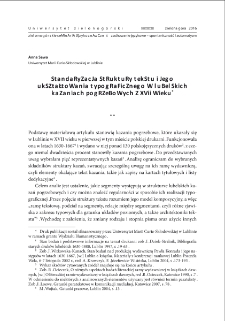Repozytorium Uniwersytetu Zielonogórskiego udostępnia 9 312 obiektów cyfrowych
Obiekt
Tytuł: Standaryzacja struktury tekstu i jego ukształtowania typograficznego w lubelskich kazaniach pogrzebowych z XVII wieku = Standardization of the text`s Structure and its typographical Shape on the example of Lublin`s Funeral Sermons from 17th century
Współtwórca:
Hawrysz, Magdalena - red. nauk. ; Uździcka, Marzanna - red. nauk. ; Wojciechowska, Anna - red. nauk.
Tytuł publikacji grupowej:
Streszczenie:
W funkcjonującej w latach 1630-1667 w Lublinie drukarni ukazywały się liczne kazania pogrzebowe. Podstawą materiałową badań jest pięć reprezentatywnych utworów należących do tej odmiany piśmiennictwa. Analizowane kazania mają standardową budowę - składają się z karty tytułowej, listu dedykacyjnego i tekstu głównego. Na stronie recto ich kart tytułowych znajdują się: motyw przewodni kazania; imię, nazwisko i określenia etykietalne zmarłego; imię i nazwisko kaznodziei wraz z informacjami o nim; czas i miejsce wygłoszenia kazania oraz adres wydawniczy. ; Odwrotna strona kart tytułowych bywa niezadrukowana lub zawiera cytat, drzeworyt herbowy albo stemmat. List dedykacyjny jest we wszystkich kazaniach poprzedzony inskrypcją wskazującą adresata listu, kończy się zaś subskrypcją wygaszającą kontakt, a często także podpisem kaznodziei. Segment centralny rozpoczyna się w każdym kazaniu cytatem z Pisma Świętego, a zamyka go formuła modlitewna. Ukształtowanie typograficzne wymienionych elementów struktury lubelskich kazań pogrzebowych świadczy o celowym charakterze rozwiązań stosowanych przez drukarzy. ; Wyrażali oni strukturalizację tekstową, wykorzystując określone rodzaje pisma drukowanego, zapisując wybrane fragmenty tekstu wielkimi literami, operując przestrzenią niezadrukowaną, stosując wyśrodkowanie, wyjustowanie, wyrównanie do prawej strony czy rozpoczynając poszczególne części tekstu na nowych stronach. Standaryzacja lubelskich kazań pogrzebowych zaznacza się więc na dwóch płaszczyznach: tekstowej i typograficznej.
Abstract:
The printing house, that worked in 1630-1667 in Lublin, published many funeral sermons, five of which are the basis of the present analysis. The structure of the analysed sermons is typical for this type of literary activity. They consist of the title page, the dedication letter and the main text of sermon. On the recto side of title page, there are such pieces of information as: the leitmotiv of the sermon, the name, surname and formal title (honorifc) of the deceased, the name, surname of the preacher with some information about him, the place and time of preach and the address where the sermon was issued. ; The reverse of the title page sometimes is not printed or there are some quotations, heraldic woodblock prints or other heraldic emblems. The dedication letter is always preceded by an inscription that points at the addressee and is finished by a subscription that suppresses contact. Finishing the dedication letter with the signature of preacher is also very common. The central part is started by a quotation from the Holy Bible and is finished by a prayerful formula. The typographical structure of the mentioned elements of funeral sermons issued in Lublin in 17th century attest to the intentional character of the solutions used by the printers. ; They expressed the structuralisation of text by using definite types of print in particular parts of the text, capital letters, unprinted space, text aligned to centre, adjusted text, text aligned to the right or starting new parts of the text on the new page. The standardization of funeral sermons from Lublin is marked at two levels: the level of the text and the typographical level.
Wydawca:
Zielona Góra: Oficyna Wydawnicza Uniwersytetu Zielonogórskiego
Format:
Identyfikator zasobu:
DOI:
Strony:
Źródło:
Zielonogórskie Seminaria Językoznawcze 2016
Jezyk:
Prawa do dysponowania publikacją:
Biblioteka Uniwersytetu Zielonogórskiego
Kolekcje, do których przypisany jest obiekt:
- Repozytorium > Jednostki organizacyjne > Wydział Humanistyczny
- Repozytorium > Typy utworów > Rozdziały w książkach
- Repozytorium > Czasopisma naukowe i serie wydawnicze UZ > Zielonogórskie Seminaria Językoznawcze
Data ostatniej modyfikacji:
2 lis 2023
Data dodania obiektu:
5 lip 2023
Liczba wyświetleń treści obiektu:
172
Wszystkie dostępne wersje tego obiektu:
https://zbc.uz.zgora.pl/repozytorium/publication/82281
Wyświetl opis w formacie RDF:
Wyświetl opis w formacie OAI-PMH:
Obiekty Podobne
Bąk, Justyna Dolański, Dariusz (1966 - ) - red.
Bell, Erin Mobley, Agnieszka - red. nauk. Fondo, Blossom N. - red. nauk. Filipczak, Iwona - red. nauk.
Wiśniowski, Aleksander Steciąg, Magdalena - red. nauk. Adamczyk, Magdalena - red. nauk. Biszczanik, Marek - red. nauk.
Kość, Józef Hawrysz, Magdalena - red. nauk. Uździcka, Marzanna - red. nauk. Wojciechowska, Anna - red. nauk.
Wojciechowska, Anna Majdańska-Wachowicz, Urszula Ruszczyńska, Marta - red. nauk. Pałucka-Czerniak, Iwona - red. nauk.

